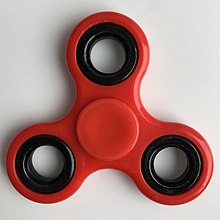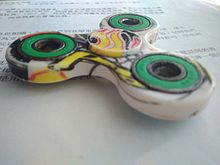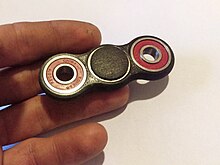Fidget spinner

A typical three-bladed fidget spinner
| |
| Type | Stress-relieving toy |
|---|---|
| Availability | 1993–present |
| Materials | Brass, stainless steel, ceramic, titanium, copper, plastics, etc. |
A fidget spinner is a toy that consists of a bearing in the center of a multi-lobed flat structure made from metal or plastic designed to spin along its axis with little effort.
Fidget spinners became popular toys in 2017, although similar devices had already been invented in 1993. The toy became popular among schoolchildren. Some schools banned the spinners for being a distraction, while other schools allowed the toy to be used discreetly.
The toy has been advertised as helping people who have trouble with focusing or fidgeting by relieving nervous energy or psychological stress. As of May 2017 there is no scientific evidence that they are effective as a treatment for autism or ADHD.
Contents
[hide]Design
Fidget spinners are useless machines designed to spin with little effort.[1][2] Basic fidget spinners consist of a two or three pronged design with a bearing in its center circular pad.[2][3] An individual holds the center pad while the toy spins.[3] Designs are made from various materials including brass, stainless steel, titanium, copper, aluminium, and plastic.[1][2][4] The types of bearings generally used are ceramic, metal (stainless steel or chrome), and hybrids--such as ceramic balls with stainless races and cages. Each fidget spinner also has 2+ weights on the outside that allow it to spin faster and to stay balanced. Additionally, bearings can be different to adjust for the design's spin time, vibration, and noise, leading to unique sensory feedback.
Origin
As of 2017 the patent status of the various fidget spinners on the market was unclear.[5]
Catherine Hettinger, a chemical engineer by training, was initially credited by some news stories to have been the inventor of the fidget spinner, including by media outlets such as The Guardian,[6] The New York Times,[7] and the New York Post.[8]Hettinger filed a patent application for a "spinning toy" in 1993 and a patent was issued, but Hettinger allowed the patent to lapse in 2005 after she could not find a commercial partner.[6][5] A May 2017 Bloomberg News article showed that Hettinger was not the inventor of the fidget spinner, and Hettinger agreed.[5]
In an interview appearing on May 4, 2017 on NPR, Scott McCoskery described how he invented a metal spinning device in 2014 to cope with his own fidgeting in IT meetings and conference calls.[9] In response to requests from an online community, he began selling the device he called the Torqbar online.[9]
Peak in popularity
On December 23, 2016, James Plafke of Forbes published an article describing fidget spinners as the "must-have office toy for 2017."[4] In late March, users on social media websites such as YouTube and Reddit began uploading videos reviewing and performing tricks with fidget spinners.[7][10] The Boston Globe reported that fidget toys in general "entered the mainstream" with the related Fidget Cube toy also rising in popularity.[1] Several sellers on Etsy were reported to be creating and selling customized spinner designs.[1]
The fidget spinner's popularity began to increase greatly in April 2017, with Google searches for "fidget spinner" spiking that month, according to Money magazine.[11][12] By May 4, variations of the spinner occupied every spot on Amazon's top 20 best seller list for toys.[11] Many publications referred to the fidget spinner as a fad, with some journalists comparing it to the rise in popularity of water bottle flipping in 2016.[13][14][13] On May 16, 2017, video game publisher Ketchapp released a fidget spinner app. The app received 7 million downloads in the first two weeks after it was released.[15]
A June 16 article on FiveThirtyEight declared that "fidget spinners are over", based on a decline from mid-May to mid-June in Google News searches, web searches and YouTube searches, combined with the number of fidget spinner videos in YouTube's top daily trending list leveling off in the US.[16]
Responses from schools
With the rapid increase in the spinner's popularity in 2017, many children and teenagers began using it in school, and some schools also reported that kids were trading and selling the spinner toys.[11][17][18]
As a result of their frequent usage by school children, many school districts banned the toy.[6][7][19] Cited reasons for their banning were often teachers arguing that the spinners distracted students from completing their school work.[11][19] According to a survey conducted by Alexi Roy of Spinner List and published in May 2017, 32% of the largest 200 American public and private high schools had banned spinners from the premises.[20]





Aucun commentaire:
Enregistrer un commentaire